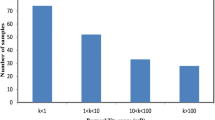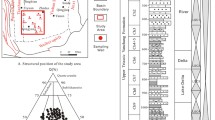Abstract
Pore structure characteristics of rock are a great concern for researchers and practitioners in rock mechanics and rock engineering fields. In this study, mercury intrusion porosimetry (MIP) was used to measure pore size distribution, as well as several important index parameters of pore structure, for seven common types of deep sedimentary rocks with a total of fifty rock samples. Results show a similar pore size distribution pattern of the rock samples in the same lithological group, but remarkable differences among different lithological groups. Among seven investigated rock types, mudstone has the smallest porosity of 3.37%, while conglomerate has the largest value of 18.8%. It is also found that the porosity of rock types with finer grain size is lower than those with coarser grain size. Meanwhile, a comparison of frequency distribution at ten intervals of pore-throat diameter among seven types of sedimentary rocks reveals that different rock types have different dominant pore-size ranges. Furthermore, permeability of the investigated sedimentary rock samples was derived based on MIP data using reported theoretical equations. Among seven rock types, mudstone has the lowest averaged permeability (3.64×10-6 mD) while conglomerate has the highest one (8.59×10-4 mD). From mudstone to conglomerate, rock permeability increases with an increase of grain size, with only an exception of siltstone which has a relatively larger porosity value. Finally, regression analysis show that there is a good fitting (R 2=0.95) between permeability and porosity which could be easily used to derive reliable permeability values of similar kinds of engineering rocks.
Similar content being viewed by others
References Cited
Al-Harthi, A. A., Al-Amri, R. M., Shehata, W. M., 1999. The Porosity and Engineering Properties of Vesicular Basalt in Saudi Arabia. Engineering Geology, 54(3/4): 313–320. doi:10.1016/s0013-7952(99)00050-2
Clavaud, J. B., Maineult, A., Zamora, M., et al., 2008. Permeability Anisotropy and Its Relations with Porous Medium Structure. Journal of Geophysical Research, 113(B1): B01202. doi:10.1029/2007jb005004
Di Benedetto, C., Cappelletti, P., Favaro, M., et al., 2015. Porosity as Key Factor in the Durability of Two Historical Building Stones: Neapolitan Yellow Tuff and Vicenza Stone. Engineering Geology, 193: 310–319. doi:10.1016/j.enggeo.2015.05.006
Dong, T., Harris, N. B., Ayranci, K., et al., 2015. Porosity Characteristics of the Devonian Horn River Shale, Canada: Insights from Lithofacies Classification and Shale Composition. International Journal of Coal Geology, 141/142: 74–90. doi:10.1016/j.coal.2015.03.001
Erguler, Z. A., Ulusay, R., 2009. Water-Induced Variations in Mechanical Properties of Clay-Bearing Rocks. International Journal of Rock Mechanics and Mining Sciences, 46(2): 355–370. doi:10.1016/j.ijrmms.2008.07.002
Gao, Z. Y., Hu, Q. H., 2013. Estimating Permeability Using Median Pore-Throat Radius Obtained from Mercury Intrusion Porosimetry. Journal of Geophysics and Engineering, 10(2): 025014. doi:10.1088/1742-2132/10/2/025014
Giesche, H., 2006. Mercury Porosimetry: A General (Practical) Overview. Particle & Particle Systems Characterization, 23(1): 9–19. doi:10.1002/ppsc.200601009
Hartmann, D. J., Beaumont, E. A., 2000. Predicting Reservoir System Quality and Performance. In: Beaumont, E. A., Foster, N. H., eds., Exploring for Oil and Gas Traps: AAPG Treatise of Petroleum Geology. Handbook of Petroleum Geology. 9-1–9-154
Hudyma, N., Avar, B. B., Karakouzian, M., 2004. Compressive Strength and Failure Modes of Lithophysae-Rich Topopah Spring Tuff Specimens and Analog Models Containing Cavities. Engineering Geology, 73(1/2): 179–190. doi:10.1016/j.enggeo.2004.01.003
Katz, A. J., Thompson, A. H., 1986. Quantitative Prediction of Permeability in Porous Rock. Physical Review B, 34(11): 8179–8181. doi:10.1103/physrevb.34.8179
Katz, A. J., Thompson, A. H., 1987. Prediction of Rock Electrical Conductivity from Mercury Injection Measurements. Journal of Geophysical Research: Solid Earth, 92(B1): 599–607. doi:10.1029/jb092ib01p00599
Loucks, R. G., Reed, R. M., Ruppel, S. C., et al., 2012. Spectrum of Pore Types and Networks in Mudrocks and a Descriptive Classification for Matrix-Related Mudrock Pores. AAPG Bulletin, 96(6): 1071–1098. doi:10.1306/08171111061
Rezaee, M. R., Jafari, A., Kazemzadeh, E., 2006. Relationships between Permeability, Porosity and Pore Throat Size in Carbonate Rocks Using Regression Analysis and Neural Networks. Journal of Geophysics and Engineering, 3(4): 370–376. doi:10.1088/1742-2132/3/4/008
Ross, D. J. K., Bustin, R. M., 2009. The Importance of Shale Composition and Pore Structure upon Gas Storage Potential of Shale Gas Reservoirs. Marine and Petroleum Geology, 26(6): 916–927. doi:10.1016/j.marpetgeo.2008.06.004
Sabatakakis, N., Koukis, G., Tsiambaos, G., et al., 2008. Index Properties and Strength Variation Controlled by Microstructure for Sedimentary Rocks. Engineering Geology, 97(1/2): 80–90. doi:10.1016/j.enggeo.2007.12.004
Siitari-Kauppi, M., Lindberg, A., Hellmuth, K. H., et al., 1997. The Effect of Microscale Pore Structure on Matrix Diffusion—A Site-Specific Study on Tonalite. Journal of Contaminant Hydrology, 26(1–4): 147–158. doi:10.1016/s0169-7722(97)00011-9
Swanson, S. M., Mastalerz, M. D., Engle, M. A., et al., 2015. Pore Characteristics of Wilcox Group Coal, U.S. Gulf Coast Region: Implications for the Occurrence of Coalbed Gas. International Journal of Coal Geology, 139: 80–94. doi:10.1016/j.coal.2014.07.012
Török, Á., Vásárhelyi, B., 2010. The Influence of Fabric and Water Content on Selected Rock Mechanical Parameters of Travertine, Examples from Hungary. Engineering Geology, 115(3/4): 237–245. doi:10.1016/j.enggeo.2010.01.005
Yilmaz, I., 2010. Influence of Water Content on the Strength and Deformability of Gypsum. International Journal of Rock Mechanics and Mining Sciences, 47(2): 342–347. doi:10.1016/j.ijrmms.2009.09.002
Zhang, N., He, M. C., Liu, P. Y., 2012. Water Vapor Sorption and its Mechanical Effect on Clay-Bearing Conglomerate Selected from China. Engineering Geology, 141/142: 1–8. doi:10.1016/j.enggeo.2012.04.007
Zhang, N., Liu, L. B., Hou, D. W., et al., 2014. Geomechanical and Water Vapor Absorption Characteristics of Clay-Bearing Soft Rocks at Great Depth. International Journal of Mining Science and Technology, 24(6): 811–818. doi:10.1016/j.ijmst.2014.10.013
Author information
Authors and Affiliations
Corresponding author
Rights and permissions
About this article
Cite this article
Zhang, N., He, M., Zhang, B. et al. Pore structure characteristics and permeability of deep sedimentary rocks determined by mercury intrusion porosimetry. J. Earth Sci. 27, 670–676 (2016). https://doi.org/10.1007/s12583-016-0662-z
Received:
Accepted:
Published:
Issue Date:
DOI: https://doi.org/10.1007/s12583-016-0662-z




